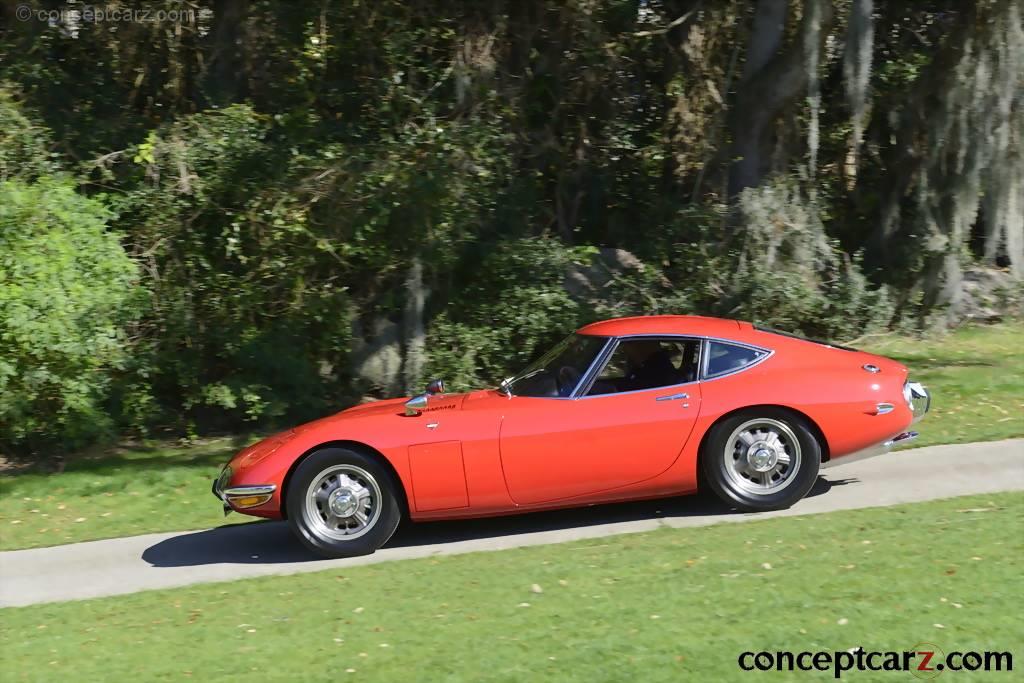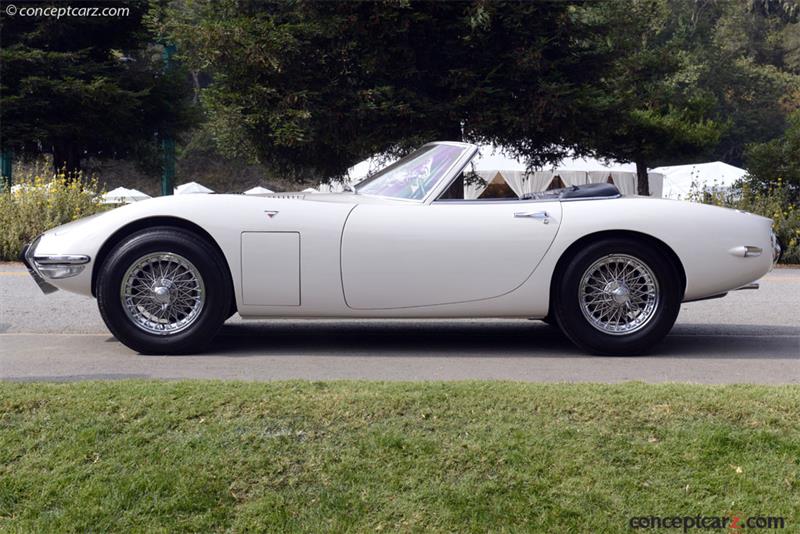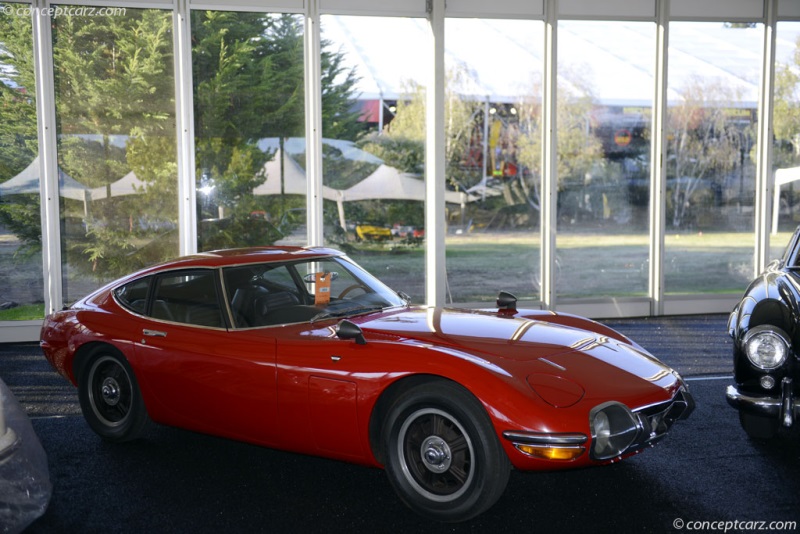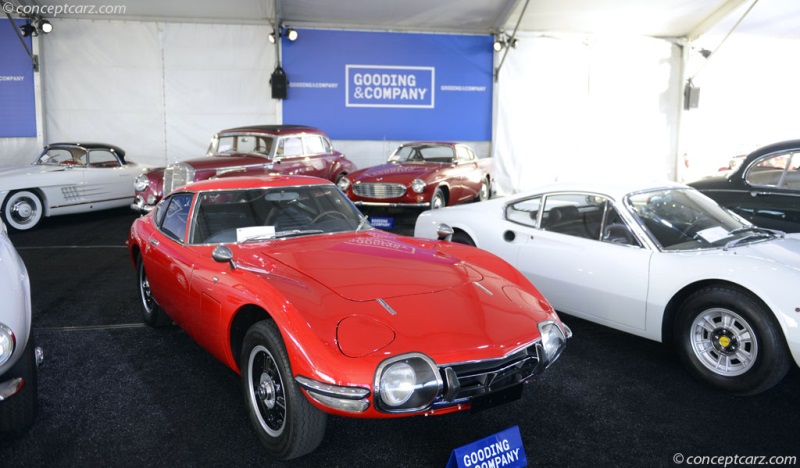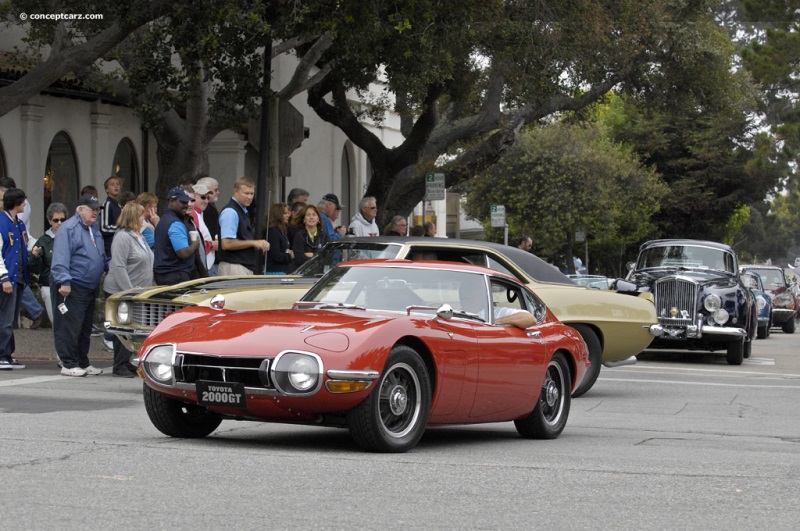1967 Toyota 2000 GT Navigation
The world first saw the Toyota 2000 GT at the 1965 Tokyo Motor Show and production began two years later, continuing in limited numbers until 1970. This vehicle was very important for the Toyota Motor Company because it proved to the world that they could produce sports cars and not just economical and practical vehicles. It was a halo model that brought international awareness of the Japanese brand, and competed with the finest European sports and GT cars.
Coupe
Chassis #: P-112
Engine #: 10157
View info and historyThe genesis of the 2000 GT began with the creation of Project 280A in the summer of 1964. Toyota partnered with Japanese motorcycle builder Yamaha for the engineering of a two-liter, six-cylinder, twin-cam engine based upon an existing Toyota cylinder block found in the top-of-the-line Toyota Crown sedan. Yamaha fitted three two-barrel Mikuni-Solex 40 PHH carburetors and a new DOHC head, resulting in an output of 150 horsepower and a zero-to-sixty mph time for the 2,500-pound car in ten seconds. The top speed was achieved at 137 mph. Most of the 2000GTs were equipped with the 2.0-liter straight-6 engine, with nine examples receiving a 2.3-liter (2M-B) SOHC engine which produced 138 horsepower at 5,800 RPM and 3,800 RPM. Both the 2.0- and 2.3-liter engines were backed by a five-speed manual transmission and three different final drive ratios were available, with the 4.375 ratio promising a top speed of 135 mph. The four-wheel power-assisted disc brakes and the limited-slip differential were a 'first' for a Japanese car. This was also the first Toyota vehicle to offer rack and pinion steering. The suspension used coil springs and double wishbones in the front and rear.The elegant and athletic styling was inspired by Lotus' Elan, with a curvaceous body that stood just 47 inches high. It was styled in-house by Satoru Nozaki, receiving minimal bumpers, pop-up headlights above large circular plexiglass-covered driving lamps flanking a protruding grille. The rear fastback roofline was similar to an E-Type Jaguar, with a pair of round tail and brake lights in the back. In August of 1969, the rear turn signals were enlarged, while the front driving lamps became smaller and the turn signals were given a new shape 
Coupe
Chassis #: P-112
Engine #: 10157
View info and historyThe interior was comfortable but, as one might expect from such a small footprint, cramped. Yamaha's musical instrument woodworking facilities provided the walnut or rosewood veneer dashboard inlays, adding a touch of luxury and increasing its credentials as a 'luxurious GT.' The auto-signal-seeking radio tuner was another luxury item uncommon to many vehicles of the era. The cars built near the end of production received changes to their interior and could be fitted with optional air conditioning and an automatic transmission. With the air-conditioner installed, an additional scoop was fitted underneath the grille to provide air to the unit. Production
During its short production lifespan, only 337 examples were produced. 11 months after the project had begun, the first prototype had been completed, in August of 1965. The production version arrived two years later, with 223 MF10s (2.0-liter 3M DOHC I6) eventually built at the Yamaha factory in Iwata, Shizuko, along with 109 examples of the MF10Ls and nine MF12Ls (2.3-liter 2M-B SOHC I6). Production lasted from May of 1967 until August of 1970. It is believed that approximately 60 examples were sold to North America with a base price of about $6,800. Most examples of the 2000GT were painted in Solar Red or Pegasus White. Thunder Silver metallic, Bellatrix Yellow, Atlantis Green, and Twilight Turquoise metallic were much more exclusive.James Bond
The only body style produced was the coupe resting on a 91.7-inch wheelbase with a length of 164.4-inches and a width of 63 inches. When the 2000GT played a starring role in the 1967 James Bond movie You Only Live Twice, it did not have a top. Two one-off convertibles were built specifically for the film, perhaps to accommodate Sean Connery's 6-foot, 2-inch stature. These two cars retained the original car's fastback profile but were devoid of rear side windows. In the film, the only person to drive the open-top 2000GT was 'Bond Girl' Aki (Akiko Wakabayashi).Motorsports
Toyota's halo car enjoyed a rather impressive racing career, placing third in the 1966 Japanese Grand Prix at Fuji. Its inaugural win was achieved at the inaugural Suzuka 1000 Kilometres in 1966, followed by another victory in the 24 Hours of Fuji and the Fuji 1000 Kilometres in 1967. Carroll Shelby's contract with Ford Racing had just concluded when he excepted a contract from Toyota to develop the 2000GT for SCCA Production Competition. Toyota sent three cars (chassis 10001, 10005, 10006) to Shelby in California, where they were modified to current SCCA regulations and prepared for the 1968 season. Chassis number 10001 was tested for the first time at Riverside Raceway in California by Formula One driver Ronnie Bucknum. Following two test outings, and fitted with several suspension and engine modifications by Shelby, Dave Jordan took to the track for a third test and shaved over four seconds off the lap times. The Toyota 2000GT was poised to make an imprint on the American racing scene.
Coupe
Chassis #: P-112
Engine #: 10157
View info and historyDave Jordan raced the #23 car during the 1968 SCCA season, and the 2000GT showed true potential in the C-Production series. Two of the 2000GTs would finish the season with an overall finishing record above 80-percent. The car driven by Jordan earned two 1st place, four 2nd place, and three 3rd place finishes. Scooter Patrick finished 4th in the overall points championship.During their racing career, the 2000 GT set thirteen FIA world records for speed and endurance in a 72-hour test at the Yatabe High Speed Test Track in 1966.Specification
The Toyota 2000 GT rested on a 91.7-inch wheelbase and had an overall length of 164.4 inches, a width of 63 inches, and stood 43.5 inches high for the roadster and 45.7 inches for the coupe. The longitudinally mounted 1,988cc (121.3 CID / 2.0-liter) straight 6 engine had three two-barrel Mikuni-Solex 40 PHH carburetors, dual overhead camshafts, and delivered 148 horsepower at 6,600 RPM and 129 lb-ft of torque. Nine examples received the larger but lower output SOHC 2.3-liter 2M-B engine with 138 horsepower and 148 lb-ft of torque. The engines were paired with a five-speed manual transmission, sending power to the rear wheels via three different final drives and a limited-slip differential. Power-assisted disc brakes, a first for a Japanese car, were standard. The steering was by rack and pinion and the suspension was comprised of coil springs attached to double wishbones.
by Daniel Vaughan | Jun 2006

Coupe
Chassis #: P-112
Engine #: 10157
View info and history

Coupe
Chassis #: P-112
Engine #: 10157
View info and history
During its short production lifespan, only 337 examples were produced. 11 months after the project had begun, the first prototype had been completed, in August of 1965. The production version arrived two years later, with 223 MF10s (2.0-liter 3M DOHC I6) eventually built at the Yamaha factory in Iwata, Shizuko, along with 109 examples of the MF10Ls and nine MF12Ls (2.3-liter 2M-B SOHC I6). Production lasted from May of 1967 until August of 1970. It is believed that approximately 60 examples were sold to North America with a base price of about $6,800. Most examples of the 2000GT were painted in Solar Red or Pegasus White. Thunder Silver metallic, Bellatrix Yellow, Atlantis Green, and Twilight Turquoise metallic were much more exclusive.James Bond
The only body style produced was the coupe resting on a 91.7-inch wheelbase with a length of 164.4-inches and a width of 63 inches. When the 2000GT played a starring role in the 1967 James Bond movie You Only Live Twice, it did not have a top. Two one-off convertibles were built specifically for the film, perhaps to accommodate Sean Connery's 6-foot, 2-inch stature. These two cars retained the original car's fastback profile but were devoid of rear side windows. In the film, the only person to drive the open-top 2000GT was 'Bond Girl' Aki (Akiko Wakabayashi).Motorsports
Toyota's halo car enjoyed a rather impressive racing career, placing third in the 1966 Japanese Grand Prix at Fuji. Its inaugural win was achieved at the inaugural Suzuka 1000 Kilometres in 1966, followed by another victory in the 24 Hours of Fuji and the Fuji 1000 Kilometres in 1967. Carroll Shelby's contract with Ford Racing had just concluded when he excepted a contract from Toyota to develop the 2000GT for SCCA Production Competition. Toyota sent three cars (chassis 10001, 10005, 10006) to Shelby in California, where they were modified to current SCCA regulations and prepared for the 1968 season. Chassis number 10001 was tested for the first time at Riverside Raceway in California by Formula One driver Ronnie Bucknum. Following two test outings, and fitted with several suspension and engine modifications by Shelby, Dave Jordan took to the track for a third test and shaved over four seconds off the lap times. The Toyota 2000GT was poised to make an imprint on the American racing scene.
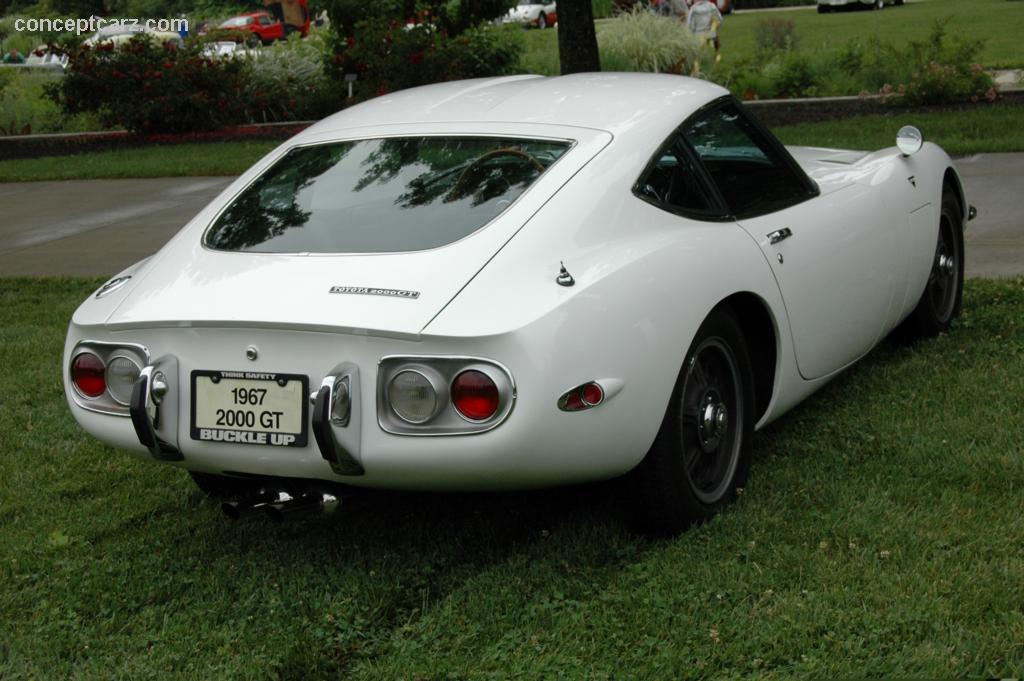
Coupe
Chassis #: P-112
Engine #: 10157
View info and history
The Toyota 2000 GT rested on a 91.7-inch wheelbase and had an overall length of 164.4 inches, a width of 63 inches, and stood 43.5 inches high for the roadster and 45.7 inches for the coupe. The longitudinally mounted 1,988cc (121.3 CID / 2.0-liter) straight 6 engine had three two-barrel Mikuni-Solex 40 PHH carburetors, dual overhead camshafts, and delivered 148 horsepower at 6,600 RPM and 129 lb-ft of torque. Nine examples received the larger but lower output SOHC 2.3-liter 2M-B engine with 138 horsepower and 148 lb-ft of torque. The engines were paired with a five-speed manual transmission, sending power to the rear wheels via three different final drives and a limited-slip differential. Power-assisted disc brakes, a first for a Japanese car, were standard. The steering was by rack and pinion and the suspension was comprised of coil springs attached to double wishbones.
by Daniel Vaughan | Jun 2006
Related Reading : Toyota 2000 GT History
Thrilling automotive admirers, collectors and historians for over 40 years, the Toyota 2000GT was Japans original exclusive sports car. Created in a joint collaboration by Toyota and Yamaha, this exceptional and exotic GT is still appreciated today for not only its beauty and performance but also its historic significance. Japans first supercar, the 2000GT was a limited-production, rear-wheel drive,....
Continue Reading >>
Continue Reading >>
- 1967 Toyota 2000 GT Menu
- Article
- Image gallery
- Valuation
- Specifications
- Profiles
- Production figures
Toyota
Similar Vehicles
Similar Automakers
Similarly Sized Vehicles
from 1967
- Alfa Romeo Giulia
Alfa Romeo GT 1300 Junior
Alfa Romeo TZ2
BMW 1600
Chevrolet Camaro
Ferrari 330 P4
Ferrari 412 P
Marcos 1600 GT
Mazda Cosmo Sport 110S
Porsche 911
Toyota Monthly Sales Volume
September 2024
140,152
June 2024
164,777
March 2024
184,123
1967 Toyota 2000 GT Vehicle Profiles
Recent Vehicle Additions
Performance and Specification Comparison
2000 GT Specification Comparison by Year
Year
Production
Wheelbase
Engine
Prices
Related Automotive News

The all-new BMW X2 and the first-ever BMW iX2
Second generation BMW X2 Sports Activity Coupé blends a new dynamic style, cutting edge technology, increased space and exceptional comfort Fully-electric BMW iX2 introduced for the first time, offering a range of up to 266 miles...

V-Series Blackwing: Ultimate Track Capability, Zero Compromise
The 2022 Cadillac CT4-V Blackwing and CT5-V Blackwing, two of the most powerful Cadillacs ever, raise the bar on performance
The 2022 Cadillac CT5-V Blackwing and CT4-V Blackwing represent the pinnacle of Cadillac performance and craftsmanship,...

THE McLAREN F1
FOR THE DRIVER VITALLY – AS IN ONE OF McLARENS WORLD CHAMPION RACING CARS – DRIVER AND VEHICLE BECOME ENTIRELY AS ONE
The primary design consideration for the McLaren F1 has been to make it without reserve a drivers car, an extremely high-performance...
RRDC VOTES IN 26 NEW MEMBERS FOR 2015
HILLIARD, Ohio (Oct. 23, 2015) - Twenty-six race-car drivers and motorsports professionals have been voted into the Road Racing Drivers Club in 2015. The group includes 11 Regular Members from the open-wheel and sports-car racing ranks, 10 Associate...
RRDC VOTES IN 37 NEW MEMBERS FOR 2013
HILLIARD, Ohio (Nov. 7, 2013) - Thirty-seven race-car drivers and motorsports professionals have been voted into the Road Racing Drivers Club in 2013. The group includes 13 Regular Members from the open-wheel and sports-car racing ranks, 20 Associate...
